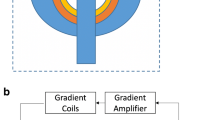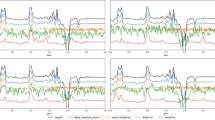Abstract
Objective
Prospective motion correction can effectively fix the imaging volume of interest. For large motion, this can lead to relative motion of coil sensitivities, distortions associated with imaging gradients and B 0 field variations. This work accounts for the B 0 field change due to subject movement, and proposes a method for correcting tissue magnetic susceptibility-related distortion in prospective motion correction.
Materials and methods
The B 0 field shifts at the different head orientations were characterized. A volunteer performed large motion with prospective motion correction enabled. The acquired data were divided into multiple groups according to the object positions. The correction of B 0-related distortion was applied to each group of data individually via augmented sensitivity encoding with additionally integrated gradient nonlinearity correction.
Results
The relative motion of the gradients, B 0 field and coil sensitivities in prospective motion correction results in residual spatial distortion, blurring, and coil artifacts. These errors can be mitigated by the proposed method. Moreover, iterative conjugate gradient optimization with regularization provided superior results with smaller RMSE in comparison to standard conjugate gradient.
Conclusion
The combined correction of B 0-related distortion and gradient nonlinearity leads to a reduction of residual motion artifacts in prospective motion correction data.








Similar content being viewed by others

References
Bydder M, Larkman DJ, Hajnal JV (2002) Detection and elimination of motion artifacts by regeneration of k-space. Magn Reson Med 47:677–686
Atkinson D, Hill DL, Stoyle PN, Summers PE, Clare S, Bowtell R, Keevil SF (1999) Automatic compensation of motion artifacts in MRI. Magn Reson Med 41:163–170
Batchelor PG, Atkinson D, Irarrazaval P, Hill DL, Hajnal J, Larkman D (2005) Matrix description of general motion correction applied to multishot images. Magn Reson Med 54:1273–1280
Thesen S, Heid O, Mueller E, Schad LR (2000) Prospective acquisition correction for head motion with image-based tracking for real-time fMRI. Magn Reson Med 44:457–465
Ward HA, Riederer SJ, Grimm RC, Ehman RL, Felmlee JP, Jack CR Jr (2000) Prospective multiaxial motion correction for fMRI. Magn Reson Med 43:459–469
Zaitsev M, Dold C, Sakas G, Hennig J, Speck O (2006) Magnetic resonance imaging of freely moving objects: prospective real-time motion correction using an external optical motion tracking system. NeuroImage 31:1038–1050
Maclaren J, Herbst M, Speck O, Zaitsev M (2013) Prospective motion correction in brain imaging: a review. Magn Reson Med 69:621–636
Maclaren J, Lee KJ, Luengviriya C, Speck O, Zaitsev M (2011) Combined prospective and retrospective motion correction to relax navigator requirements. Magn Reson Med 65:1724–1732
Banerjee S, Beatty PJ, Zhang JZ, Shankaranarayanan A (2004) Parallel and partial Fourier imaging with prospective motion correction. Magn Reson Med 69:421–433
Atkinson D, Larkman DJ, Batchelor PG, Hill DL, Hajnal JV (2004) Coil-based artifact reduction. Magn Reson Med 52:825–830
Aksoy M (2008) Effect of Motion-Induced Altered Coil Sensitivity on Parallel Imaging Performance. In: Proceedings of the 16th scientific meeting, International Society for Magnetic Resonance in Medicine, Toronto, p 3111
Luengviriya C (2010) Necessity of sensitivity profile correction in retrospective motion correction at 7T MRI. In: Proceedings of the ISMRM Workshop on Current Concepts of Motion Correction for MRI & MRM, Austria, p 10
Bammer R, Aksoy M, Liu C (2007) Augmented generalized SENSE reconstruction to correct for rigid body motion. Magn Reson Med 57:90–102
Polzin JA, Kruger DG, Gurr DH, Brittain JH, Riederer SJ (2004) Correction for gradient nonlinearity in continuously moving table MR imaging. Magn Reson Med 52:181–187
Hu HH, Madhuranthakam AJ, Kruger DG, Glockner JF, Riederer SJ (2005) Continuously moving table MRI with SENSE: application in peripheral contrast enhanced MR angiography. Magn Reson Med 54:1025–1031
Yarach U, Luengviriya C, Danishad A, Stucht D, Godenschweger F, Schulze P, Speck O (2015) Correction of gradient nonlinearity artifacts in prospective motion correction for 7T MRI. Magn Reson Med 73:1562–1569
Jezzard P, Balaban RS (1995) Correction for geometric distortion in echo planar images from B0 field variations. Magn Reson Med 34:65–73
Jezzard P, Clare S (1999) Sources of distortion in functional MRI data. Hum Brain Mapp 8:80–85
Ooi MB, Muraskin J, Zou X, Thomas WJ, Krueger S, Aksoy M, Bammer R, Brown TR (2013) Combined prospective and retrospective correction to reduce motion-induced image misalignment and geometric distortions in EPI. Magn Reson Med 69:803–811
Speck O, Stadler J, Zaitsev M (2008) High resolution single-shot EPI at 7T. Magn Reson Mater Phy 21:73–86
Sulikowska A, Wharton S, Glover PM, Gowland PA (2014) Will field shifts due to head rotation compromise motion correction. ISMRM-ESMRMB in Milan. http://cds.ismrm.org/protected/14MPresentations/0885/. Accessed 12 August 2015
Fessler J, Sutton B (2003) Nonuniform fast Fourier transforms using min–max interpolation. IEEE Trans Signal 51:560–574
Tao S, Trzasko JD, Shu Y, Huston J III, Bernstein MA (2015) Integrated image reconstruction and gradient nonlinearity correction. Magn Reson Med 74:1019–1031
Pruessmann KP, Weiger M, Bornert P, Boesiger P (2001) Advances in sensitivity encoding with arbitrary k-space trajectories. Magn Reson Med 46:638–651
Qu P, Luo J, Zhang B, Wang J, Shen GX (2007) An Improved iterative SENSE reconstruction method. Magn Reson Eng 31:44–50
Hansen PC (1998) Rank-deficient and discrete ill-posed problems: numerical aspects of linear inversion. SIAM, Philadelphia, p 247
Knoll F, Schultz G, Bredies K, Gallichan D, Zaitsev M, Hennig J, Stollberger R (2013) Reconstruction of undersampled radial PatLoc imaging using total generalized variation. Magn Reson Med 70:40–52
Fessler J (2014) Image reconstruction toolbox. The University of Michigan, Ann Arbor, Michigan, USA. http://web.eecs.umich.edu/_fessler/irt/fessler.tgz. Accessed 12 April 2014
Yoder DA, Zhao Y, Paschal CB, Fitzpatrick JM (2004) MRI simulator with object-specific field map calculations. Magn Reson Imaging 22:315–328
Maclaren J, Armstrong BSR, Barrows RT et al (2012) Measurement and correction of microscopic head motion during magnetic resonance imaging of the brain. PLoS ONE. doi:10.1371/journal.pone.0048088
Wey HY, Huang JC, Hsu YY, Lim K, Kuan WC, Chen CC, Liu HL (2006) Image quality testing using an oil-filled ACR MRI phantom at 3.0 T. In: Proceedings of the 48th scientific meeting, The American Association of Physicists in Medicine (AAPM), Orlando, p 5044
Lu K, Liu TT, Bydder M (2008) Optimal phase difference reconstruction: comparison of two methods. Magn Reson Imaging 26:142–145
FMRIB Software Library, University of Oxford (2012). http://www.fmrib.ox.ac.uk/fsl. Accessed on 12 April 2015
Robinson S, Jovicich J (2011) B0 mapping with multi-channel RF coils at high field. Magn Reson Med 66:976–988
Haase A, Frahm J, Matthaei D, Hanicke W, Merboldt KD (1986) FLASH imaging. Rapid NMR imaging using low flip-angle pulses. J Magn Reson 67:258–266
Archip N, Clatz O, Whalen S, Dimaio SP, Black PM, Jolesz FA, Golby A, Warfield SK (2008) Compensation of geometrical distortion effects on intraoperative magnetic resonance imaging for enhanced visualization in image-guided neurosurgery. Neurosurgery 62:209–216
Sumanaweera T, Adler JR, Napel S, Glover GH (1994) Characterization of spatial distortion in magnetic resonance imaging and its implications for stereotaxic surgery. Neurosurgery 35:696–704
Vogel CR (1996) Non-convergence of the L-curve regularization parameter selection method. Inverse Prob 12(4):535–547
Golub GH, Heath M, Wahba G (1979) Generalized cross-validation as a method for choosing a good ridge parameter. Technometrics 21(2):215–223
Galatsanos NP, Katsaggelos AK (1992) Methods for choosing the regularization parameter and estimating the noise variance in image restoration and their relation. IEEE Trans Image Process 1(3):322–336
Walsh DO, Gmitro AF, Marcellin MW (2000) Adaptive reconstruction of phased array MR imagery. Magn Reson Med 43(5):682–690
Bernstein MA, Grgic M, Brosnan TJ, Pelc NJ (1994) Reconstruction of phase contrast, phase array multicoil data. Magn Reson Med 32:330–334
Robinson S, Horst S, Siegfried T (2014) A method for unwrapping highly wrapped multi-echo phase images at very high field: UMPIRE. Magn Reson Med 72:80–92
Hutton C, Bork A, Josephs O, Ceichmann R, Ashburner J, Turner R (2002) Image distortion correction in fMRI: a quantitative evaluation. Neuroimage 16(1):217–240
In MH, Speck O (2012) Highly accelerated PSF-mapping for EPI distortion correction with improved fidelity. MAGMA 25(3):183–192
Ooi MB, Krueger S, Muraskin J, Thomas WJ, Brown TR (2011) Echo-planar imaging with prospective slice-by-slice motion correction using active markers. Magn Reson Med 66(1):73–78
Koch KM, Papademetris X, Rothman D, de Graaf RA (2006) Rapid calculations of susceptibility-induced magnetostatic field perturbations for in vivo magnetic resonance. Phys Med Biol 51:6381–6402
Jenkinson M, Wilson JL, Jezzard P (2004) Perturbation method for magnetic field calculations of nonconductive objects. Magn Reson Med 52:471–477
Boegle R, Maclaren J, Zaitsev M (2010) Combining prospective motion correction and distortion correction for EPI: towards a comprehensive correction of motion and susceptibility-induced artifacts. Magn Reson Mater Phy 23:263–273
Ward HA, Riederer SJ, Jack CR (2002) Real-time auto shimming for echo planar timecourse imaging. Magn Reson Med 48:771–780
Hess AT, Dylan Tisdall M, Andronesi OC, Meintjes EM, van der Kouwe AJW (2011) Real-time motion and B0 corrected single voxel spectroscopy using volumetric navigators. Magn Reson Med 66(2):314–323
Keating B, Ernst T (2012) Real-time dynamic frequency and shim correction for single-voxel MR spectroscopy. Magn Reson Med 68(5):1339–1345
Shi Y, Vannesjo J, Miller K, Clare S (2015) Field-Map-Free First-Order Dynamic Shimming. In: Proceedings of the 23rd scientific meeting, International Society for Magnetic Resonance in Medicine, Toronto, p 0096
Barmet C, De Zanche N, Pruessmann KP (2008) Spatiotemporal magnetic field monitoring for MR. Magn Reson Med 60:187–197
Duerst Y, Wilm BJ, Dietrich BE, Vannesjo SJ, Barmet C, Schmid T, Brunner DO, Pruessmann KP (2014) Real-time feedback for spatiotemporal field stabilization in MR systems. Magn Reson Med 73(2):884–893
Wilm BJ, Barmet C, Pavan M, Pruessmann KP (2011) Higher order reconstruction for MRI in the presence of spatiotemporal field perturbations. Magn Reson Med 65:1690–1701
Hansen MS, Atkinson D, Sorensen TS (2008) Cartesian SENSE and k-t SENSE reconstruction using commodity graphics hardware. Magn Reson Med 59(3):463–468
Zhang T, Pauly JM, Vasanawala SS, Lustig M (2013) Coil compression for accelerated imaging with cartesian sampling. Magn Reson Med 69:571–582
Acknowledgments
The study was supported by the BMBF (Forschungscampus STIMULATE, 03FO16101A) and NIH (DA021146). We greatly appreciate all support from the BMMR Mo-Co team. C. Luengviriya thanks the Center for Advanced Studies of Industrial Technology, Kasetsart University for financial support.
Author information
Authors and Affiliations
Corresponding author
Ethics declarations
Conflict of interest
The authors have no conflict of interest.
Ethical standard
The measurements on human subjects in this study have been approved by the local ethics committee and have therefore been performed in accordance with the ethical standards laid down in the Declaration of Helsinki. All involved subjects have given their informed consent before recruitment in the study.
Rights and permissions
About this article
Cite this article
Yarach, U., Luengviriya, C., Stucht, D. et al. Correction of B 0-induced geometric distortion variations in prospective motion correction for 7T MRI. Magn Reson Mater Phy 29, 319–332 (2016). https://doi.org/10.1007/s10334-015-0515-2
Received:
Revised:
Accepted:
Published:
Issue Date:
DOI: https://doi.org/10.1007/s10334-015-0515-2



